

 |
Search the Site with

|
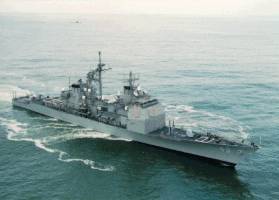 | 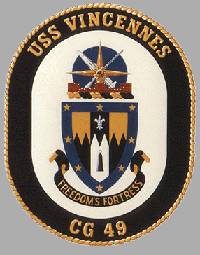 | 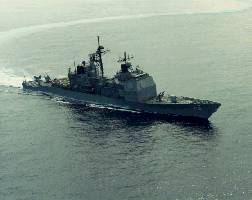 |
USS VINCENNES was the third ship in the TICONDEROGA - class and the first cruiser in that class equipped with the three-legged main mast. Stricken from the Navy list on June 29, 2005, she was sold for scrapping to International Shipbreaking of Brownsville, Tx., on July 9, 2010. VINCENNES arrived under tow at Brownsville on November 21, 2010, and has since been broken up.
| General Characteristics: | Awarded: August 28, 1981 |
| Keel laid: October 19, 1982 | |
| Launched: January 14, 1984 | |
| Commissioned: July 6, 1985 | |
| Decommissioned: June 29, 2005 | |
| Builder: Ingalls Shipbuilding, West Bank, Pascagoula, Miss. | |
| Propulsion system: four General Electric LM 2500 gas turbine engines | |
| Propellers: two | |
| Blades on each Propeller: five | |
| Length: 567 feet (173 meters) | |
| Beam: 55 feet (16.8 meters) | |
| Draft: 34 feet (10.2 meters) | |
| Displacement: approx. 9,600 tons full load | |
| Speed: 30+ knots | |
| Cost: about $1 billion | |
| Aircraft: two | |
| Armament: two | |
| Crew: 33 Officers, 27 Chief Petty Officers and approx. 340 Enlisted |
Crew List:
This section contains the names of sailors who served aboard USS VINCENNES. It is no official listing but contains the names of sailors who submitted their information.
USS VINCENNES Cruise Books:
About the Ship's Coat of Arms:
 The three divisions of the shield represent the three circumnavigations of the earth made by the first vessel to bear the name VINCENNES, and contain allusions to activities of these expeditions. The intended fess line represents the ice of the Antarctic continent which was discovered and named by LT Charles Wilkes of Vincennes in 1840. The Antarctic wastes and icebergs are alluded to by the white area in center base which bears a lead line weight of the early 19th Century period, referring to the new data in charts and cartography gathered by the surveys made during expeditions with VINCENNES as flagship. The silver fleur-de-lis in chief refers to the French origin of the name VINCENNES and the fort in Indiana after which the ships were named.
The three divisions of the shield represent the three circumnavigations of the earth made by the first vessel to bear the name VINCENNES, and contain allusions to activities of these expeditions. The intended fess line represents the ice of the Antarctic continent which was discovered and named by LT Charles Wilkes of Vincennes in 1840. The Antarctic wastes and icebergs are alluded to by the white area in center base which bears a lead line weight of the early 19th Century period, referring to the new data in charts and cartography gathered by the surveys made during expeditions with VINCENNES as flagship. The silver fleur-de-lis in chief refers to the French origin of the name VINCENNES and the fort in Indiana after which the ships were named.
The eight gold stars on a light blue border represent the Battle Stars awarded to CA-44 and CL-64 during World War II and refer again to the State of Indiana, whose flag bears gold stars on a blue field. Then Navy is represented on the shield by dark blue and gold, colors usually associated with the Navy.
The embattled wall recalls the Fort Vincennes in Indiana. Its color, red, refers to battle, and the three battlements to the three earlier vessels named VINCENNES. The compass rose represents global navigation and exploration. The clover is a reference to the new ship's distinction as third of its class, and recalls the botanical surveys of the first VINCENNES. The guided missile and rifle represent new and old weaponry carried by the latest and the first VINCENNES. The blue disc is a reference to the Antarctic skies and the first Vincennes' explorations.
About the Cruiser’s Name:
USS VINCENNES is the fourth capital warship to bear this name and a city in Indiana, 55 miles south of Terra Haute. The city is the site of the old Fort Vincennes, captured during the American Revolution in 1779 by George Rogers Clark.
The first VINCENNES was one of ten Sloops-of-War to be authorized by Congress in 1825. For 41 years, she compiled an outstanding record of unprecedented achievements in polar exploration, global circumnavigation and distinguished service in the War Between the States. The second VINCENNES, designated (CA 44), was a heavy cruiser commissioned in 1937. She fought valiantly during General Jimmy Doolittle's raid on Tokyo, the Battle Midway, the landing at Guadalcanal, and finally, at the Battle of Savo Island. The third VINCENNES (CL 64) was commissioned in January 1944 and fought brilliantly throughout the Pacific in Battles of Guam, the Philippines, Okinawa, and Formosa. During the closing months of World War II, VINCENNES became legendary for her successes against Japanese aircraft.
Accidents aboard USS VINCENNES:
| Date | Where | Events |
|---|---|---|
| October 9, 2004 | Yokosuka, Japan | A Pacific typhoon causes the USS VINCENNES to snap away from the pier at Yokosuka, Japan and to collide with the USS CORONADO (AGF 11). There are no casualties or injuries reported as a result of the collision. |
History of USS VINCENNES:
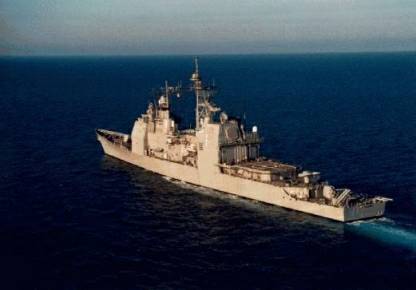 The VINCENNES was the first of the United States Navy's
The VINCENNES was the first of the United States Navy's
VINCENNES deployed in August 1986 to the Western Pacific and Indian Oceans. During the "first ever" Pacific Deployment of an
On 20 April 1988, during Fleet Exercise 88-1, VINCENNES was given unexpected orders to proceed back to San Diego and make preparations to leave on a six month deployment. One month later, the ship entered the Persian Gulf, to become part of the Joint Task Force in the Persian Gulf. During the course of this assignment it made fourteen transits of the Straits of Hormuz in support of Operation Earnest Will.
On July 3, 1988, during Operation Earnest Will, VINCENNES was situated in the Persian Gulf when the cruiser shot down an Iranian commercial Airbus A300B2-202 (Iran Air Flight 655) after mistaking it for an Iranian
On February 22, 1996, the US agreed to pay Iran $61.8 million in compensation ($300,000 per wage earning victim, $150,000 per non wage earner) for the 248 Iranians killed in the shootdown.
In February of 1990, VINCENNES deployed on her third six month tour of the Western Pacific and Indian Oceans, In addition to covering the fleet with the "Aegis Shield" and coordination all Battle Group air events, VINCENNES served as the Command and Control Flagship during Harpoon-Ex-90. VINCENNES spent more time at sea during deployment than any other ship in the Battle Group. In July 1990. VINCENNES returned home after steaming nearly 100,000 miles. She deployed with
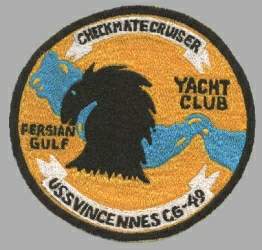 In August 1991, VINCENNES departed for her fourth Western Pacific Deployment. Transiting with the USS INDEPENDENCE (CV 62), VINCENNES performed duties as the Anti-Air Warfare Commander for Battle Group Delta until detaching to participate as the United States representative in MERCUBEX 91, a joint United States and Singaporean exercise. Over the next three months, VINCENNES participated in the bilateral exercise VALIANT BLITZ with the South Korean Navy, the bilateral exercise ANNUALEX 03G with the Japanese Maritime Self Defense Force, and ASWEX 92-1K with the South Korean Navy before reaching Hong Kong to act as the U.S. representative for the Navy Days ceremonies. VINCENNES returned from deployment on the 21st of December 1991.
In August 1991, VINCENNES departed for her fourth Western Pacific Deployment. Transiting with the USS INDEPENDENCE (CV 62), VINCENNES performed duties as the Anti-Air Warfare Commander for Battle Group Delta until detaching to participate as the United States representative in MERCUBEX 91, a joint United States and Singaporean exercise. Over the next three months, VINCENNES participated in the bilateral exercise VALIANT BLITZ with the South Korean Navy, the bilateral exercise ANNUALEX 03G with the Japanese Maritime Self Defense Force, and ASWEX 92-1K with the South Korean Navy before reaching Hong Kong to act as the U.S. representative for the Navy Days ceremonies. VINCENNES returned from deployment on the 21st of December 1991.
In June 1994, VINCENNES departed on her fifth Western Pacific deployment Transiting with the USS KITTY HAWK (CV 63) Battle Group, VINCENNES performed duties as Anti-Air Warfare Commander for the Battle Group. During deployment, VINCENNES conducted an Anti-Submarine exercise, PASSEX 94-2, with the Japanese Maritime Self Defense Force, the bilateral exercise MERCUB 94-2, a joint U.S. and Singaporean Navy exercise of the Malaysian peninsula, he bilateral exercise KEEN EDGE, with the Japanese Maritime Self Defense Force, and TANDEM THRUST, a larger scale joint exercise which VINCENNES participated as the Area Air Defense Coordinator for the entire joint operating area. VINCENNES returned from deployment on the 22nd of December 1994.
USS VINCENNES changed homeport in August 1997 from San Diego to Yokosuka, Japan.
USS VINCENNES, forward deployed to Yokosuka, Japan, took part in Exercise Valiant Usher 98-1 with USS BELLEAU WOOD (LHA 3) amphibious ready group and the Royal Australian Navy destroyer HMAS PERTH (DDG 38). The combined exercise took place near Townsend Island, Australia.
VINCENNES also took part in the U.S. Seventh Fleet's Fleet Battle Experiment Delta (FBE-D) from October 24 to November 2, 1998, in conjunction with exercise Foal Eagle, a regularly scheduled exercise that simulates the defense of the Republic of Korea. Sponsored by the Navy Warfare Development Command, FBE-D is the fourth in a series of experiments that test newly emerging combat systems and procedures in an operational environment. Fleet Battle Experiments are designed as genuine experiments, not demonstrations or exercises. Each experiment has a hypothesis and specific, carefully considered measures of effectiveness. Unlike a demonstration, failure is acceptable; in fact, just as much can be learned from failure as from success. The results of FBE-D will have a direct influence on future naval force structure and capabilities.
USS VINCENNES completed Sharem 134, a bilateral exercise conducted with several Japanese ships and other U.S. participants, on August 12, 2000. The exercise included a week of undersea warfare training and data collection in the South China Sea. The ship’s submarine detection capabilities were tested during the five-day event, and new submarine prosecution procedures were developed. Events included sonar range testing, sonobuoy employment methods and submarine engagement tactics using VINCENNES' embarked LAMPs helo detachment, HSL 51 Det. 6. The final Sharem events included a freeplay, which allowed the cruiser to detect and prosecute other submarines within the operations area, combining many of the tactics and systems tested during Sharem.
In mid-November 2000, the vessel took part in MISSILEX 01-1 during which it test fired various missile batteries at remote controlled aerial drones provided by Fleet Activities Okinawa.
On March 23, 2001, USS VINCENNES, as part of the USS KITTY HAWK (CV 63) Battle Group, cruised into Changi Naval Base, marking the first time a U.S. carrier has moored pierside in Singapore. VINCENNES took part from August 23-27, 2001, in a military training exercise called Multi-Sail, featuring U.S. Navy ships and aircraft and Japan Maritime Self-Defense Force units. Multi-Sail is designed to provide U.S. and Japanese forces interoperability training in multiple warfare areas. The training exercises the units' skill in surface, air defense and undersea warfare required to jointly defend Japan against external aggression.
USS VINCENNES departed Yokosuka on September 17, 2001, to conduct operations in support of Operation Enduring Freedom and returned on December 18, 2001 after more than three months at sea.
In addition to performing duties as the Battle Group Anti-Air Warfare Commander during her Western Pacific Deployments, VINCENNES has been awarded the Navy Meritorious Unit Citation, the Battle "E" three times, the Combat Action Ribbon, the National Defense Medal, and the Sea Service Deployment Ribbon with four stars.
USS VINCENNES Patch Gallery:
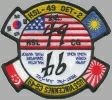 |  |
USS VINCENNES Image Gallery:
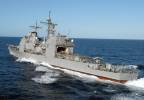 |  | 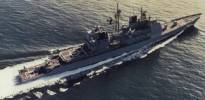 |  | 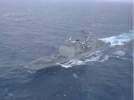 |
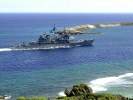 | 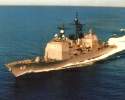 | 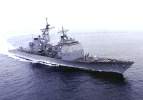 | 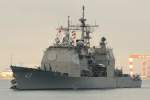 | 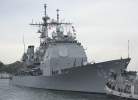 |
The photos below were taken by William Chiu when USS VINCENNES visited Hong Kong. The first two photos were taken in 1992 and the last four ones were taken in December 1991.
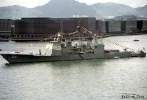 | 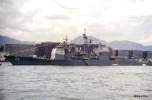 | 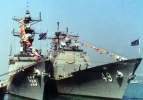 | 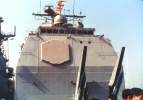 | 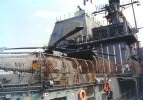 |
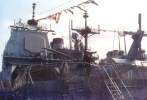 |
The photo below was taken by Ian Johnson and shows the VINCENNES in Fremantle Harbor, Australia, on April 24, 2004. This was VINCENNES' third and final visit to Fremantle. At the time, VINCENNES operated with the KITTY HAWK (CV 63) strike group.
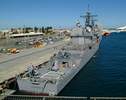 |
The photos below were taken by me and show the VINCENNES laid-up at the Puget Sound Naval Shipyard, Bremerton, Wash., on March 14, 2010.
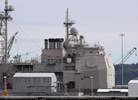 | 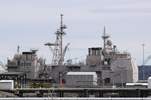 | 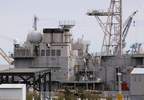 |  | 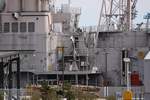 |
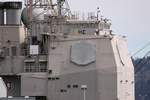 | 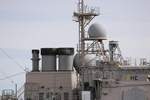 | 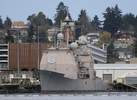 |
The photos below were taken by Don Nathan and show the VINCENNES laid-up at the Puget Sound Naval Shipyard, Bremerton, Wash., on April 16, 2010.
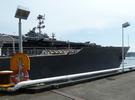 | 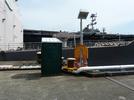 |  |  | 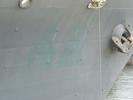 |
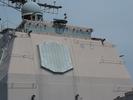 | 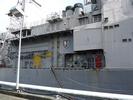 | 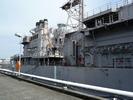 | 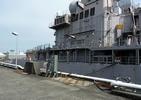 | 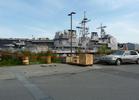 |
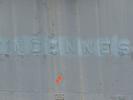 | 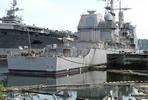 |
 Back to Cruisers list.
Back to Cruisers list.  Back to ships list.
Back to ships list.  Back to selection page.
Back to selection page.  Back to 1st page.
Back to 1st page.